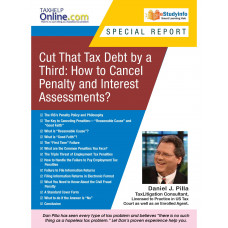Cut That Tax Debt by a Third: How to Cancel Penalty and Interest Assessments
- Author Daniel J. Pilla
- Product Code: ESDB003
- Availability: In Stock
Does your client qualify for a penalty abatement or a refund of paid penalties?
IRS penalties and interests keep on increasing every month if your taxes are outstanding after the filing deadline. You are liable to pay penalties and interests on the entire outstanding amount even if you have qualified for a tax debt payment plan and have started to make payments. Sometimes penalties can go up to 25 per cent solely on the discretion of the IRS. Also, the federal agency charges an additional penalty of 5 per cent on taxes that have not been filed.
Just about every one of the over 140 penalty provisions contains a “reasonable cause” provision. This means that when you acted in good faith and based upon a reasonable cause for your actions, the penalty does not apply. Penalties are designed to achieve voluntary compliance by penalizing deliberate, non-compliant behaviour. They are not intended to make matters worse for delinquent citizens who are otherwise honest.
Penalty abatement is a technique that tax practitioners can utilize to help their clients reduce their tax debt or even entirely cancel penalties and interests they owe to the IRS. The trick is to convince the IRS that your client was unable to pay the taxes due to what the IRS tags a “reasonable cause.”
If a practitioner or taxpayer can justify that reasonable cause led to delay in tax payment, there are good chances that the IRS may forgive a portion or the entire penalty charged on your tax debt. Remember that IRS is softer on failure to pay penalties than failure to file penalties. The purpose of penalties and interests are to encourage and motivate taxpayers to pay their taxes on time and it must be considered as such.
Daniel will teach you all the insider tips, tricks and secrets To win cancellation of a penalty, you must establish that you had a “reasonable cause” for your actions and that you acted in “good faith.” Let us examine both of these concepts in detail. (e-Book size: 8 x 11 format 58 pages).
Learning Objectives:
- The IRS’s Penalty Policy and Philosophy
- The Key to Canceling Penalties— “Reasonable Cause” and “Good Faith”
- What is “Reasonable Cause”?
- What is “Good Faith”?
- The “First Time” Failure
- What are the Common Penalties You Face?
- The Triple Threat of Employment Tax Penalties
- How to Handle the Failure to Pay Employment Tax Penalties
- Failure to File Information Returns
- Filing Information Returns in Electronic Format
- What You Need to Know About the Civil Fraud Penalty
- A Standard Cover Form
- What to do if the Answer is “No”
- Conclusion
Daniel J. Pilla has been the nation's leader in taxpayers' rights defense and IRS abuse prevention and cure. Dan has seen every type of tax problem and believes "there is no such thing as a hopeless tax problem." Widely regarded as one of the country's premiere experts in IRS procedures, he has helped countless thousands of citizens solve personal and business tax problems they thought might never be solved.








